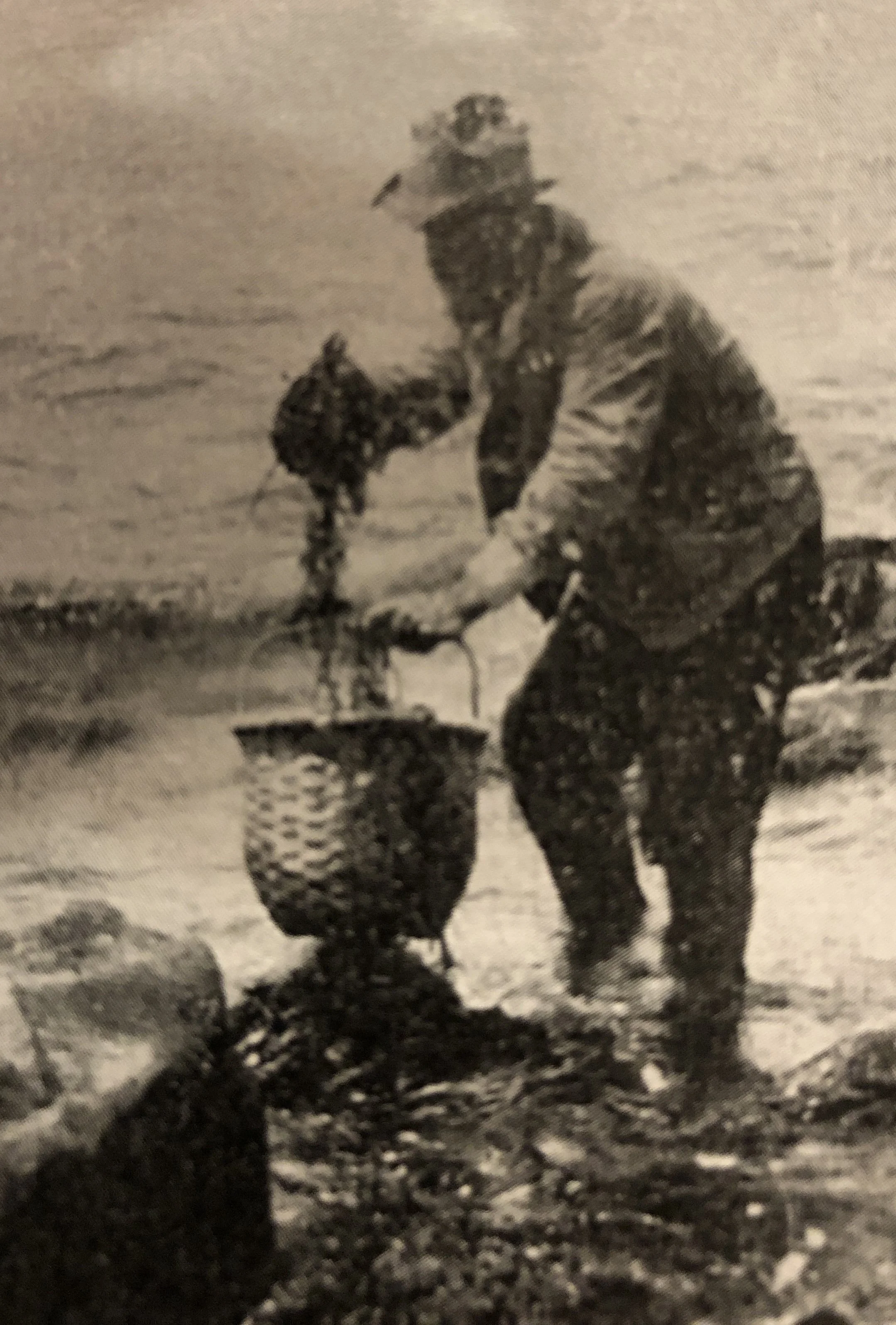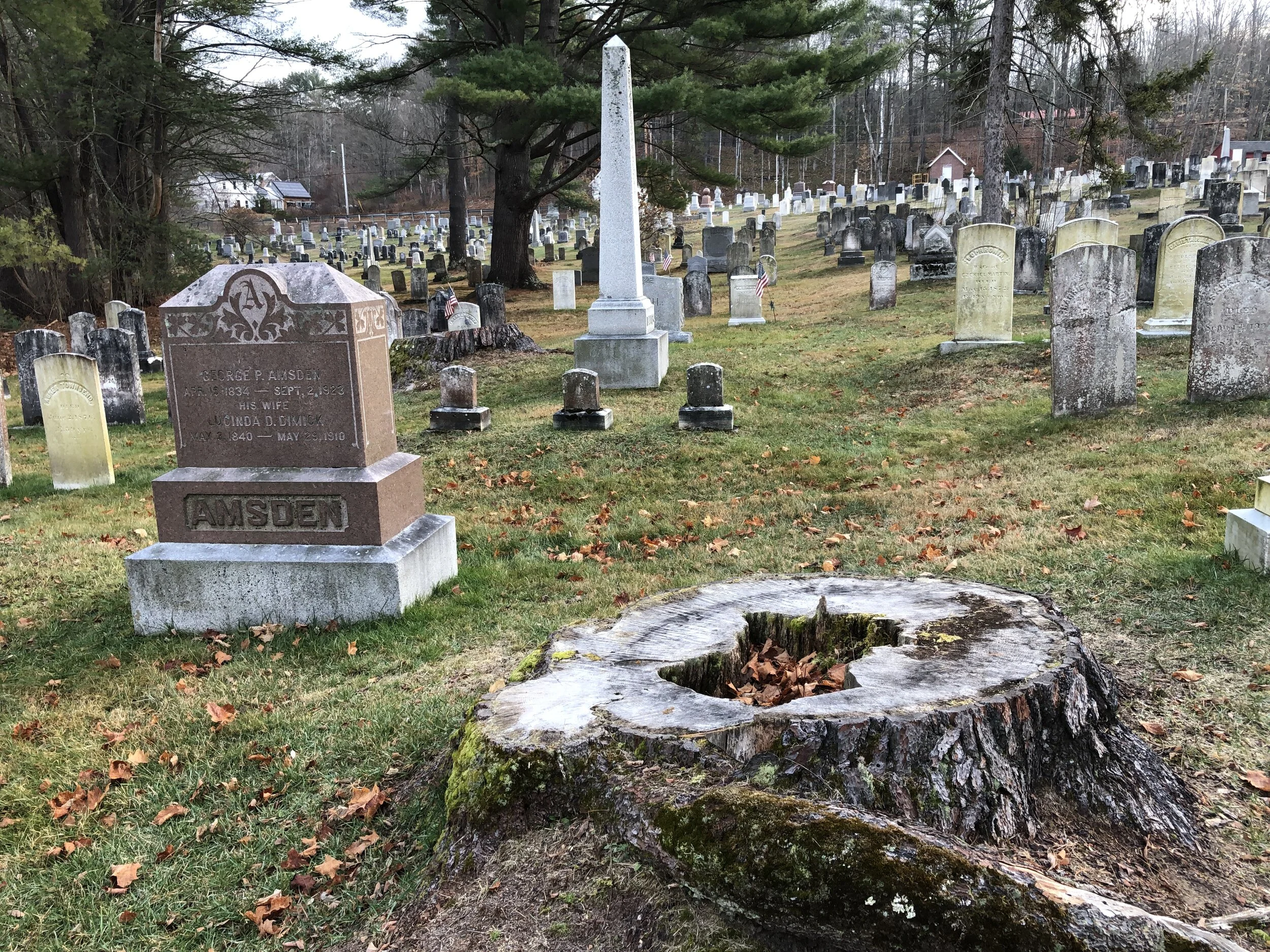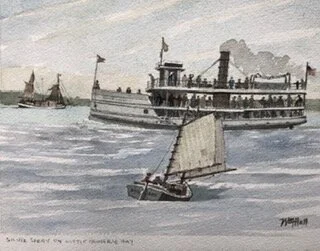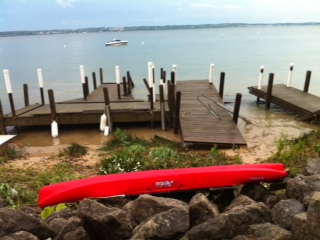
Islanders using everything they can from the sea
In this watercolor by William Hall, Block Islanders in the 19th Century are collecting fin fish, crabs and lobsters trapped in tidal pools. They also harvested large amounts of seaweed to be used for food and fertilizer. See photos below. This painting is part of an extensive series of watercolors Mr. Hall has done over the past decade of people at work.
He is represented by, among other venues, David Chatowsky Art Gallery, 47 Dodge St., Block Island, R.I. (401) 835-4623
One recipe for “seaweed pudding”:
Put a cup of dried seaweed in a pan and add a liter of whole milk.
Gently bring to boil and simmer for 10 to 15 minutes.
Strain through a fine sieve or a muslin cloth into a bowl and cool.
Put in a refrigerator to set for a couple of hours.
The harvesting of seaweed — mostly kelp — (including increasingly from aquaculture) for food and many other uses has greatly increased in the past few years. And seaweed aquaculture is more and more promoted for environmental reasons. For one thing, it absorbs some of the excess carbon dioxide put into the atmosphere by fossil-fuel burning. For another, seaweed — especially “kelp forests” — is a home for many species.
Collecting seaweed in locally made baskets.
Spreading seaweed as fertilizer on a Block Island farm.
'Tangled floor'
In the graveyard of Lyme, N.H.
—Photo by William Hall
A stand of trees
you know the kind,
a golden grove,
a farmer’s pride.
Are now but stumps
with greening sprouts
that struggle upward
to find some light.
Gone the careful line
along the lane
the cluster’s done
and so the shade.
I oftentimes came
to sense the souls
that rested there deep
below those pines.
More than trees
they seemed to me
a hiding place
for things I need.
I’ll not be dreaming
among those trees
with hands on bark
looking up.
There’s nothing left
but tangled floor
and nothing gained
but these metaphors.
“Epitaph,’’ by William Hall, a Rhode Island-Florida-Michigan-based painter and writer
Hard-working ferries, especially in summer
The Island Belle ferry at Old Harbor, Block Island, around 1900. Watercolor by William Hall.
Note from Mr. Hall:
I am an artist and part-time Rhode Islander who spends much of each summer in Harbor Springs, Mich., on Little Traverse Bay. This was a busy logging area in the mid 1800’s to 1935 and has also been for many years a summer place, especially for affluent people from the Midwest.
There were a total of about a dozen ferries, mostly from 58 to 96 feet long, linking several Lake Michigan communities between Petoskey and Harbor Springs between 1875 and 1930. These were steam-powered and ran a vigorous schedule, stopping every 15 minutes at docks. See one of those ferries below, and information about a Harbor Springs show of my ferry watercolors by hitting this link.
Block Island (where some of my family lived), Martha’s Vineyard and Nantucket also owe much of their development, and today’s daily bread, to such glorious little workhorses. I have painted many pictures of boats on the southern New England coast over the years. It’s fun to create images of vessels on fresh water, too.
For original art, prints, posters, drawings, information and stories, visit williamtalmadgehall.com.
Taking them in
Here’s a brand-new watercolor by William Hall. There’s show of his watercolors at the Jessie Edwards Studio, on Water Street, Block Island, R.I., through Sept. 4.
The back story of the painting here is that Howard Milikin, a great-grandfather of Mr. Hall, was a navigational pilot from Block Island. He would be ferried from Block Island to meet incoming clipper ships and then pilot them into New England ports. His license was unlimited.
Maintenance by the moon
Watercolor by William Hall, part of his show at the Jessie Edwards Gallery on Block Island, scheduled for this July.
Mr. Hall explains that this picture is about scraping the bottom of boats, in this case a Block Island Double Ender, at very low tides Seaweed and barnacles slowed work boats. So this stuff needed to be regularly scraped off. Predictable very low tides would leave parts of Old Harbor, on Block Island, above water for 6 to 8 hours a day for several days in a row in the 19th Century heyday of these boats, which were essential for the islanders' fishing and transportation needs.
Double Enders were secured to the dock to wait for the extreme low tides. When they sat on the mud the work could be done. After scraping, antifouling paint was applied. Several fishermen and their wives worked together to get the scraping and painting done fast within the window of opportunity provided by the low tides.
"Think of it as fishermen's barn-raising. Over two days several boats could fully scrapped, '' Mr. Hall says.
If you take it away, you get it for free
"Truck in the Woods'' (in Thetford, Vt.), by William Hall.










